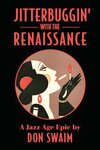

Writer Don Swaim, author of several books of historical fiction, has tackled one of the world’s most colorful eras, the 1920s, in a novel that spans the period’s final years leading to the Crash of 1929.
“Jitterbuggin’ with the Renaissance: a Jazz Age Epic” was published by Montag Press, San Francisco, and is available from Amazon.com.
Swaim is the founder of the Bucks County Writers Workshop, now in its 25th year, and co-founder and executive editor of Neshaminy: The Bucks County Historical and Literary Journal, which is celebrating its fifth anniversary.
At the height of the 1920s, mixed-race reporter Gart Asquith, protégé of H.L. Mencken, heads to New York to learn about the cultural movement known as the Harlem Renaissance. There, he mingles with gangsters, becomes pals with poet Countee Cullen, and falls in love with Zora Neale Hurston. Gart’s other capers include kidnapping Fats Waller to perform at Al Capone’s birthday party, risking arrest as a rumrunner out of Cuba, tracking down a serial killer in silent-screen Hollywood, and infiltrating the Ku Klux Klan. Many of the major figures of the Jazz Age make cameos, including George Gershwin, F. Scott Fitzgerald, and Shipwreck Kelly. All the while, Gart’s mentor Mencken, the era’s leading critic, unleashes his unfettered cynicism of politics, religion, and societal pretension. The novel’s title relates to a poem by Langston Hughes, one of the major poets of the Harlem Renaissance. Mencken’s role in the novel is not his first appearance in one of Swaim’s works of fiction. “He was the central figure in my first published book, The H.L. Mencken Murder Case, which was published in the 1980s by St. Martin’s Press,” Swaim said.
Swaim covered the Depression era in “Man With Two Faces,” the tale of a peripatetic soldier of fortune, also published by Montag. But he sees his sprawling fictional biography “The Assassination of Ambrose Bierce: A Love Story,” which spans more than 70 years starting in the 1840s, as his most ambitious published piece of work.
“Unlike many authors, I rarely write autobiographically,” Swaim said, preferring the challenge of the research and detail that leads to illuminating the times and lives of both familiar and uncommon figures of the past.
When the Bucks County Writers Workshop partnered with the Doylestown Historical Society in creating the journal Neshaminy, Swaim says he made certain that it included fiction, poetry and art.
“Fiction often illuminates the past in colorful and deeply personal ways that non-fiction cannot,” Swaim says. “Fiction even has the ability to explore deeper truths and depth of feelings that move far beyond the factual. Plus, if the writing is good, it’s fun.”
Join our readers whose generous donations are making it possible for you to read our news coverage. Help keep local journalism alive and our community strong. Donate today.